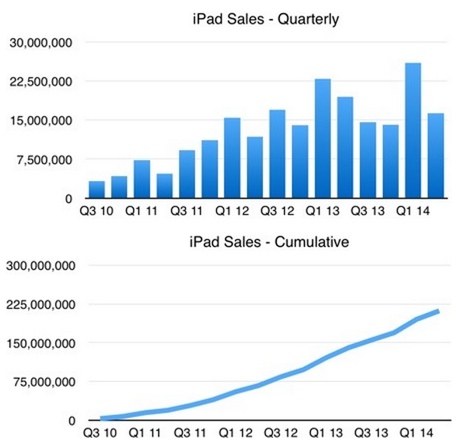How Apple is using iOS to control the iPad upgrade cycle

Following Apple's Q2 earnings there has been concern from some quarters that iPad sales are flagging and that may have hit what pundits call "peak iPad."
That's the hype, but what about the facts? The fact is that Apple is carefully controlling the iPad upgrade cycle.
Before I go on, some facts.
- Apple sold 16.35 million tablets (which includes the iPad and iPad mini tablets)
- This figure is down 37 percent on the previous quarter, and down 16 percent on the year-ago quarter
- However, it still represents the fifth best quarter for the iPad, behind Q1 14, Q1 13, Q2 13, and Q3 12.

Sales of over 16 million over a quarter isn't bad at all, especially when you consider that the iPad is only one of Apple's products. Compare this to top PC vendor Lenovo, which can't shift this many PCs — and think how big that category is — in a quarter.
Similarly, if Microsoft could shift 16 million Surface tablets in a quarter, that would be a very big deal.
OK, with that out of the way, let's now look at how Apple is using iOS to regulate the iPad upgrade cycle.
Featured
Since the iPad line first went on sale in March 2010, Apple has released seven different iPad models (excluding capacities and connectivity variants). There have been four generations of iPad, an iPad Air, and two generations of iPad mini. In all, that's over 210 million iPads sold in roughly four years.
Now here's the interesting thing. With the exception of the iPad 1, which first went on sale in April 2010 and was discontinued at the beginning of March 2011, every iPad in circulation is capable of running the latest version of iOS – iOS 7.1.1.
Apple itself admits that it sold over 15 million iPad 1 tablets before the device was discontinued, so this means that around 90 percent of all iPads ever sold are still being supported with updates.
Apple might not be selling the old hardware any more, but only about 10 percent of iPads sold are considered obsolete. Apple never once claimed that the iPad upgrade cycle would follow that of smartphones. This is fantasy straight out of the heads of analysts and pundits. The smartphone upgrade cycle is controlled by the carriers and how often they allow customers to upgrade, and is normally around two years.
The bottom line is simple – pundits who are screaming that the iPad upgrade cycle has stalled don't know what they are talking about. The truth is that the iPad upgrade cycle hasn't really started yet.
Another claim being made is that as iPad sales are dropping and hybrids are gaining ground. This chart based on Gartner data is the one being used to support this idea.
I have a few problems with this:
- First, Gartner is making predictions into 2015. As good as Gartner is, it never predicted the tablet revolution until Apple kicked it into action with the iPad. Let's see how things pan out in reality rather than make sweeping predictions based on tea leaves.
- Even if these numbers pan out exactly as stated here, the hybrid sector is only growing rapidly because it's small to begin with.
- Also, once again taking these numbers as gospel, even with the hybrid revolution, PCs are doing little more than holding their ground in the face of tablets, and unless Windows gains significant traction in that market then it will see its market share being eroded over the next few years.
- If the tablet market can become predictable in little over four years, and "peak iPad" is really a problem, then by 2015 won't the hybrid market be at the same position?
Personally, I'm hesitant to try to make such delicate preditions that go so far out. A lot of things can change.
See also: